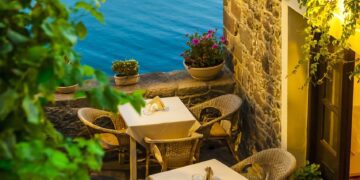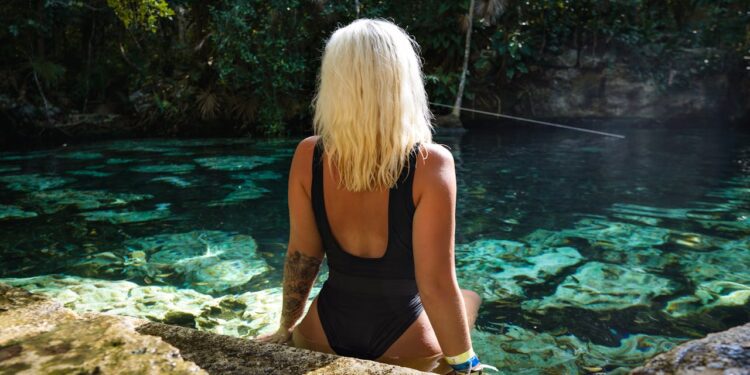Move over, Yucatán—Europe has its own chain of sapphire-and-ruby sinkholes hiding between the Adriatic and the Ionian. Pack a mask, rent a tiny hatchback, and follow this two-country secret cenotes route that links Albania’s hypnotic Blue Eye with Croatia’s bottomless Red Lake.
What exactly is a “cenote” in Europe?
The word cenote usually conjures Mexican jungle pools, but geologists use it for any water-filled limestone sinkhole connected to subterranean rivers. The western Balkans are a Swiss cheese of karst: soft carbonate rock that collapses to reveal shockingly clear springs and dizzying pits. That makes Albania and Croatia perfect bookends for a short, intensely photogenic road trip. You’ll traverse 500 km of coastal switchbacks, Ottoman towns, and wild-flower meadows, never straying far from the Adriatic yet discovering landscapes that feel almost Caribbean.
Stop 1 — Albania’s Blue Eye (Syri i Kaltër)
A natural sapphire still keeping its secrets
Just 22 km from the port city of Sarandë, a robin-egg river suddenly erupts out of a wooded hillside, forming a pulsing eye of cobalt that looks alive. Divers have touched 50 m but still haven’t found the bottom, their torch-beams swallowed by inky darkness below the turquoise halo. The spring feeds the Bistricë River at a staggering 18,400 L per second and holds a steady 10 °C year-round—perfect for cold-shock junkies, less perfect for a leisurely float.
Legends, logistics & timings
Local folklore says a monstrous snake once roamed these hills until its eye was torn out, flooding the valley; the iris now glistens under the forest canopy. To glimpse it without tour-bus crowds, arrive before 09:30 or after 16:30—locals say midday brings the “Instagram queue.” Parking and entrance currently cost 50 LEK (about €0.50) per adult; pay at the kiosk 2 km before the spring.
How to get there
- Self-drive: A compact rental from Sarandë takes 35 min; expect one last unpaved stretch.
- Bus: Hourly Gjirokastër–Sarandë services stop 2 km away—bring walking shoes.
- Tour: Day trips bundle the spring with Lekursi Castle if you’re short on time.
Responsible dips
Swimming is technically allowed, but locals urge restraint—the spring is the region’s drinking water. If you must plunge, avoid sunscreen, jewellery, and anything that could flake off. Better yet, wade downstream where the current widens and the impact is lower.
The scenic transfer: Valleys, borders & break-stops
From Blue Eye, steer north on SH99 toward Montenegro before veering inland at Makarska for Imotski, Croatia. The six-hour drive bends past:
| Kilometer Mark | Side-Trip | Why Stop? |
| 90 km | Ksamil Peninsula | white-sand bays & Greek-isle views |
| 210 km | Kotor, Montenegro | medieval walls, fjord-like bay |
| 350 km | Mostar, Bosnia-Herzegovina | Ottoman bridge jumps & cevapi lunch |
| 480 km | Biokovo Skywalk | glass walkway 1 km above the Adriatic |
Break the journey with an overnight in Mostar or Split; both boast evening promenades that feel worlds removed from early-morning cenote stares.
Stop 2 — Croatia’s Red Lake (Crveno Jezero)
Europe’s deepest water-filled sinkhole
One kilometre outside the Dalmatian town of Imotski, forest suddenly gives way to an abyss. Vertical rust-red cliffs plunge 250 m above the waterline; below, bathymetric scans show over 280 m of water—making Red Lake the deepest karst secret cenotes in Europe. Stony overhangs tint the surface emerald, turning scarlet at sunset when iron-oxide rock flares in golden light.
Can you swim it?
In a word, no. The walls are near-sheer and there’s no safe descent. Instead, hike the 45-minute rim trail for balcony views and look for daring locals testing the law of gravity by lobbing stones—legend warns misfortune if your pebble never splashes.
Trails & vantage points
- Rim Circuit (2 km, easy): Starts at the parking lay-by northeast of Imotski football stadium; picnic tables halfway.
- Topana Fortress Spur: Adds medieval ruins and a panorama that frames both Red and neighbouring Blue Lake in one grand wide-angle.
- Cycling: Rent e-bikes in Imotski; a new greenway links vineyards to sinkhole viewpoints.
Practical notes
Entrance is free, but bring water—summer sun on the limestone plateau is brutal. Spring and autumn deliver kinder temperatures and wild-sage scents; winter paints frost arabesques on the cliffs but shortens daylight.
Threading the two — building your own “Secret Cenotes Circuit”
- Duration: 5–7 days feels right—two nights in Sarandë, one in Gjirokastër’s stone mansions, one in Kotor, and two in Imotski or nearby Makarska Riviera.
- Transport: A one-way rental from Tirana to Split is possible, but cross-border fees add up; consider bus/train hops between hubs and local car hires for day runs to the actual cenotes.
- Season: Late April–June or mid-September–October balance warm water in Albania with tolerable heat in Croatia. July–August can see Blue Eye “tourist traps to avoid,” as Albanian locals put it, owing to overflow from Riviera beach resorts.
- Gear: Reef-safe sunscreen, water shoes, a drone (where legal), and a 10-stop ND filter for long-exposure shots of turquoise currents.
- Etiquette: These formations are fragile; resist carving initials or tossing coins. Support on-site cafés run by community co-ops rather than unregulated vendors.
Beyond the headline holes: Optional detours
- Buna Spring, Bosnia-Herzegovina – Orthodox monastery sits above a turquoise outlet reminiscent of Blue Eye’s colour wheel.
- Modro Jezero (Blue Lake), Croatia – Imotski’s second cenote often dries out in August, transforming into the quirkiest football pitch in Europe.
- Lake Bled’s karst sources, Slovenia – Add three days northward to finish amid alpine peaks.
Final thoughts
Europe’s cenotes don’t hide under tropical vines; they sit out in the open, framed by oak forest, vineyard, and fortress. Yet they remain astonishingly under-visited compared with Mediterranean beaches one valley over. Stringing Albania’s Blue Eye to Croatia’s Red Lake isn’t just a geologist’s fantasy road trip, it’s proofed the continent still holds pockets of raw, myth-laden nature waiting for travellers willing to veer off the A-class highways. Drive gently, tread lightly, and you’ll collect photographs that look more sci-fi than Old World.
Whether you plunge into sapphire cold or simply peer into a blood-red abyss, this secret cenotes circuit rewrites what you think a European landscape can be—and offers bragging rights that even cenote veterans in Tulum can’t match.














